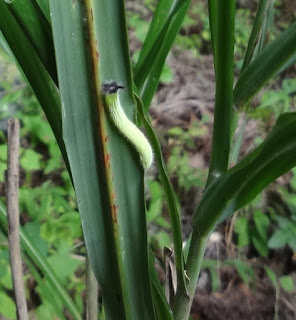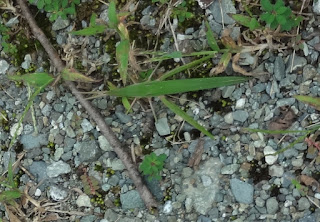It was a hot hot summer this year in Yokohama … and in September we had super-typhoons that brought sea salt inland with its rainless wind (my previous post on October 19th). I guess bugs have had a difficult life this year. For one thing, we did not have much mosquito bites during summer. People said too hot weather discouraged mosquito from searching for pray. Wow. Then, the super-typhoons browned the leaves and broke the trees. As humans flooded by the storms, the bugs must have lost meals (leaves, et al) and homes (shattered plants) … Thanks to warming planet, in October, we had relatively warmer weather, if not lots of sunshine. It let those plants that had to dishevel the leaves in September to sprout new leaves, as in early spring. Now in November, the tired bugs were meandering between the browned leaves, still green remaining plants, and strangely fresh green of buds. As a candidate of becoming a creepy-crawly for the next reincarnation, I am observing the life of bugs this autumn. It seems it has been not at all easy. (A free internet horoscope concluded my next reincarnation is an insect; please see my previous post on July 6th, 2018) Well, I have to accept their life, perhaps.
 |
| A
Japanese walnut tree in the middle of this November in Yokohama. It has desiccated leaves due to salt damage … and fresh new leaves sprouting. What are they going to do during winter? |
 |
| Lamium amplexicaule flowering this November. It’s one of those early spring flowers. Something is wrong … |
One of the shocking sceneries I encountered this summer was caterpillar fungus 冬虫夏草. When we forest instructors did a vegetation census along Hadano Forestry Road 秦野林道, one of my seniors spotted a ghostly white cicada almost pasted on a rock. It was a corpse of the insect infested by sac fungi. The bug was “frozen” on the spot, and from all over its body, numerous white tiny protuberances sprouting. Scientifically speaking, it was yet at the stage of fungi imperfecti so that mycelia were spreading over the body of the cicada by asexual reproduction. Perhaps the bug was dead quite recently. Eventually, the fungus would produce sporocarp, a more familiar version of Cordyceps explained in illustrated references (such as this one). Cicadas spend 99% of their life underground sucking liquid from conducting vessel of plants. Nutritionally speaking, it’s a poor meal, but the insect rears symbiotic bacteria inside which can help maximizing the dietary value of their drinks. Recently, Japanese scholars found that the DNA of the bacteria has evolutionally close and on-going relation with caterpillar fungi that kill the cicadas. Caterpillar fungus is one of the most expensive ingredients of Chinese medicine, although scientific analysis of their medicinal effects has not progressed much. More molecular study of cicada, bacteria, and caterpillar fungus can yield break-through for medicines of immune activation, antibacterial, and immunosuppressive substances, the scholars expect ... If I were that cicada after the reincarnation, and my infested body would be a part of scientific progress of humans, I think I could murmur “I accept …” According to this HP of a company developing beds of edible mushrooms, there are about 450 kinds of known caterpillar fungi, and Japan had roughly 350 of them. Ours is a wet country and inevitably fungi infested bodies of insects are abundant in the forest, if you look.
 |
| A
Cicada infested by caterpillar fungus in Hadano Forestry Road |
In summer, butterflies are busy finding their mate. After flush dances of couples to mate, females lay eggs on trees suitable for their baby. In September, caterpillars still have time to be adults before winter arrives. But sometimes, the babies would come too late, like in November, to survive in freezing environment of coming season. Meanwhile, in late autumn those once flashy butterfly adults could have worn-out wings, but still wander for the dwindling supply of honey and pollens of flowers … This week in downtown Yokohama, I’ve observed a literally drop-dead Pseudozizeenriu maha in front of my step. It came fluttering among steps of busy people, and then stalled to fall on the asphalt. Why it came to such a concreted space, I don’t know. That’s … a philosophical incident. When I would reincarnate in a tiny butterfly, and go popped-off on the pavement, what might I think at the last moment? Or a bug cannot think or feel?
 |
| A Daimio tethys near Lake Sagami 相模湖 this July. They rest characteristically on leaves and flowers by opening their wings like this, which look like a costume of high-ranking Samurai, aka Daimio, 200 years ago. Maybe it completed mating duty already and took a mini-break. Their caterpillars overwinter under fallen leaves in a form of last instar larvae. |
 |
| A
dating of Old world swallowtail near
Lake Sagami. They were so busy and didn’t care while I took photos. |
 |
| A
caterpillar of Dark evening brown in Yadoriki Water Source Forest やどりき水源林 this September . It will soon be a pupa, and become an autumn adult (; this butterfly also has summer adult which has darker color) to sleep under warm fallen leaves during winter. |
 |
| A
caterpillar of Cabbage white in
November. It overwinters in pupa. I hope it can find a winter home before a car crumples it flat. |
In one October weekend for Niiharu Citizen Forest, I met a large, about 10cm long, Hierodula patellifera (praying mantis) whose left wing was tragically missing. It displayed the soft under wing and belly normally covered by seemingly strong outer wing. It was easy to recognize its 2 oviducts sticking out from the tale. It was she. To reach to that size, I imagined she has survived many near-misses … and was finally caught up with her fate. It slowly proceeded on a narrow community road that is used by visitors and farmers, with occasional cars and motorbikes. Yet, the insect sidled up to somewhere safer, with nobility. The scene was like a shot in a tragic action movie where an amazing heroin was killed in action … I was a sort of moved … If I would reincarnate …
 |
| Bette Davis in Niiharu Citizen Forest |
 |
| She was stunning from the back as well. |
Grasshoppers are normally green in mid-summer for camouflage. By October the majority of them has finished the job of reproduction, and turns brown as plants preparing for winter. In late autumn of Yokohama, many Acrida cinerea (Chinese grasshopper) grow big, like 5-7cm, or more, long. They are ending their life, but their ability to hop is still going strong even when they are brown and large. In Yokohama’s suburb, they are hopping from gardens to gardens by crossing paved roads that are busy with cars. One day in November, I saw a large brown Chinese grasshopper hopped along a road running through a row of detached houses. It took its pace to move around, not in a hurry. Then, from a corner, a car appeared and turned to the direction of the bug. I expected to observe a tragedy. Nope. The senior insect rhythmically avoided the ferociously approaching tires. After the monster had gone, it kept hopping at its own speed and disappeared in a garden nearby. I was impressed. When I reincarnate, I hope I could act with dignity like that Acrida cinerea. Someday, perhaps.
 |
| A Yellow spotted stink bug, in a lady’s room of a department store of downtown Yokohama! |
If you find an environmental issues
in Kanagawa Prefecture, please make a contact with Kanagawa Natural Environment Conservation
Center 神奈川県自然環境保全センター
657 Nanasawa, Atsugi City, 243-0121 〒243-0121 厚木市七沢657
Phone: 046-248-0323
You can send an enquiry to them by
clicking the bottom line of their homepage at http://www.pref.kanagawa.jp/div/1644/





No comments:
Post a Comment